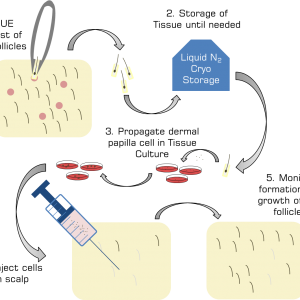
The ability to generate new hair from your old hair would be an incredibly powerful tool. Current treatments for hair loss focus on keeping the hair you have or transplanting the limited permanent hair of the scalp to areas where hair has been lost.
Hair cloning, sometimes called hair multiplication, gives us the ability to amplify the hair follicles that you have, into a large pool of transplantable cells that can each form into a hair follicle and begin the hair production cycle.
Cloning is a technique for taking biological material and replicating it over and over. The early definition of cloning was actually not related to full organisms it was simply referring to the production of copies of DNA. The aim of this foundational work was to develop methods using bacteria as small DNA machines to produce large quantities of DNA for other experiments. The modern discussion of cloning became co-opted in science fiction and generally has little to do with producing whole organisms.
Research into the potential uses for cloning human tissue has been much more limited. Currently, it is difficult to perform human tissue cloning research in Canada or the United States; however, it is possible in the United Kingdom.
A new company, aptly named HairClone©, located in the UK is currently seeking investors for the development of technology that they are confident will allow for the proliferation of human hair producing cells.
Method
In brief, their method is to harvest roughly 50 hair follicles from the patient through FUE harvest (Figure 1). These follicles would then be sent for cryopreservation until the patient is ready. Cryopreservation is already a common practice for storing viable human tissue for many years and is routine in tissue culture labs around the world. From a regulatory standpoint, final approval of these methods is made easier by the fact that the source material is the patient’s own scalp and not from donor sources.
Once the call is made that the patient is ready for the surgery, the dermal papilla cells are brought out of storage and induced to proliferate (i.e., multiply at an exponential rate) (Figure 1). It is reasonable to expect that if the technology is successful as claimed that the small amount of material obtained in the original FUE harvest would be enough to produce large numbers of hair follicles. The amplified cells are then injected into the scalp at a similar depth to the natural hair follicles.
The injected cells now will either migrate to nearby viable, albeit miniaturized, follicles to push them back into the hair growth cycle or they will form the basis for a new hair follicle. The time frame for hair regrowth is not known at this time and could take longer than traditional hair transplants.
The exciting aspect of hair cloning is the potential for large numbers of scalp hair from the patient for the patient. The chance or rejection of the transplanted cells is low as the immune system will recognize the cells as itself. Additionally, the cells are expanded from follicles will be taken from permanent regions of the scalp and the produced cells should not be as sensitive to DHT as the previous miniaturized follicles.
Exciting future
While this technology is not currently available yet, we at Sure Hair are excited by the potential to provide these types of treatments when they are deemed safe and approved for the public.













